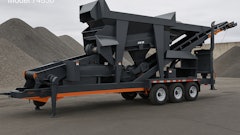Like many of my North American media counterparts, as well as manufacturing execs, dealer reps, contractors and others planning to attend the bauma show in Munich last month, I found myself grounded by, of all things, a volcano in Iceland. All that week, I kept thinking about the events I was missing, and lamenting the fact that an innocuous-looking cloud hovering thousands of feet above Europe was keeping me from exploring the "miles of aisles" of construction equipment innovations.
For those of you who have never been to bauma, "miles" is not an exaggeration. This year's show featured 663,774 sq. yds. (555,000 sq. meters) of aisle upon aisle of heavy iron and components. bauma earns its reputation as the world's largest construction industry trade show, and this year was no exception, volcanic ash notwithstanding.
Thankfully, we did have two Cygnus staffers already in Germany at the time of the travel disruptions who were able to report back to us on the events, and mood, at the show. According to our colleagues, the mood was decidedly upbeat in spite of the reduced number of overseas attendees. Overall, more than 415,000 visitors made it through the show gates from 200+ countries.
Those who did make it proved to be in a buying mood. Many exhibitors report they saw strong sales activity. Take Zeppelin-Cat, for example. Its show sales figures far exceeded expectations. In fact, it sold 800+ units on the first day, despite the fact that many attendees didn't make it in until mid-week. "The good old times are coming back," asserts Michael Heidemann, managing director of Zeppelin and CEO of Zeppelin Baumaschinen GmbH.
While it may not feel like it, the U.S. construction industry may not be that far behind in its recovery. New housing starts rose for the third straight month in March, with building permits jumping 7.5% - the highest level since October 2008. The value of nonresidential construction rose 4.5% from year-ago levels, with Q1 2010 up 8.6% from Q1 2009 levels (Reed Construction Data). And economists surveyed by The National Association for Business Economics have come out as increasingly optimistic about real U.S. GDP and job growth for 2010, both of which are leading indicators for future construction activity.
Projects funded by the American Recovery and Reinvestment Act (ARRA) have also begun to move into full swing. ARRA-financed projects increased to 8,761 in March, and grew again to 9,395 in April. As of mid-month, cumulative total stimulus outlays had reached $7.28 billion, with another $5.40 billion obligated to projects yet to start work.
Construction employment is showing some signs of life, as well. In March, industry employment rose by 15,000 to 5,592,000, the first gain since June of 2007. It expanded in 26 states plus the District of Columbia; fell in 22 states; and was unchanged in two.
So what do these statistics mean in real terms? Clearly, the U.S. construction industry isn't out of the woods yet. The coming months will remain a struggle for many. But these and other indications are signs the worst may be behind us.
We may never truly see a return to the "good old times"; but better times are inevitable. So bid what makes sense, keep costs in check and maintain what margins you can until they arrive.


















